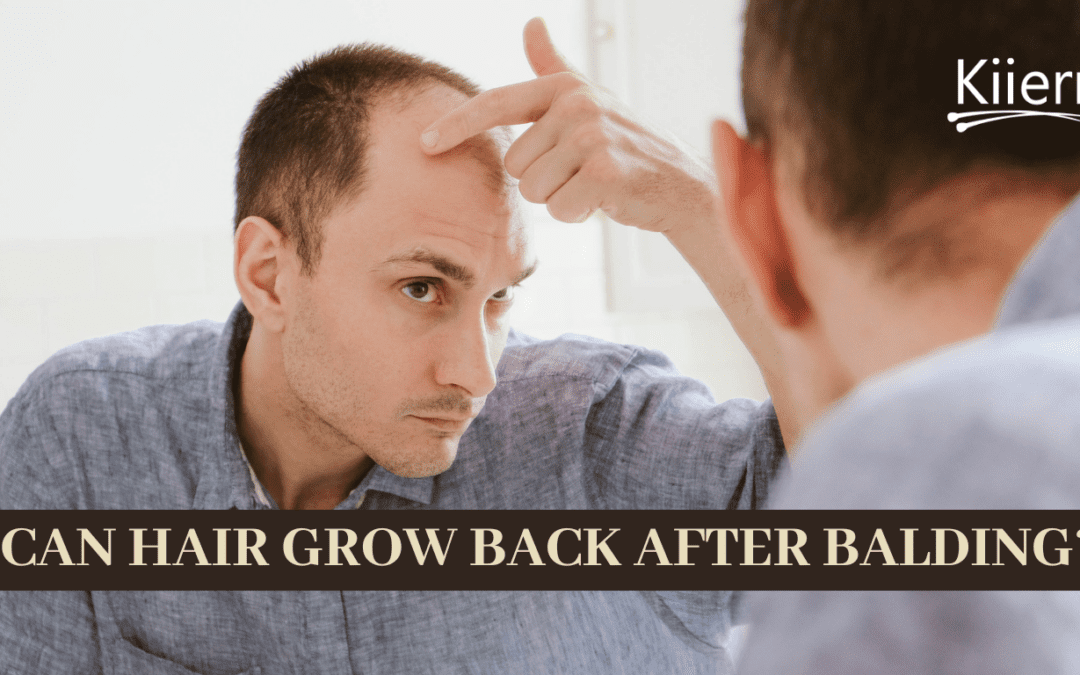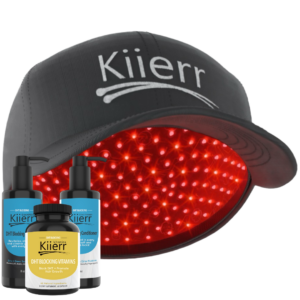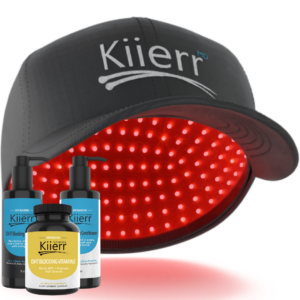If you’re experiencing hair loss or balding, we want you to know that you’re not alone. It’s estimated that by the age of 50, approximately 85% of men will experience some degree of hair loss. And women are also affected, with up to 40% experiencing hair loss by the age of 50. While hair loss can be distressing, it’s important to know that there are options available for promoting hair growth and restoring confidence. In this blog, we’ll explore the science of hair growth, common causes of balding, natural ways to promote hair growth, medical treatments, hair growth products and supplements, lifestyle changes, and coping strategies for dealing with hair loss. Our aim is to provide you with information, resources, and support to help you on your hair growth journey.
Table of Contents
- 1 Understanding Hair Growth After Balding
- 2 Common Causes of Balding and How They Affect Hair Growth
- 3 The Science of Hair Growth: Exploring the Hair Growth Cycle
- 4 Natural Ways to Promote Hair Growth After Balding
- 5 Medical Treatments for Hair Growth After Balding
- 6 Hair Growth Products and Supplements for Balding Men and Women
- 7 Dealing with Hair Loss: Coping Strategies and Resources for Support
- 8 Consencious: Can You Grow Hair Back After Experiencing Balding?
Understanding Hair Growth After Balding

Hair growth after balding is possible, but the success of regrowth depends on the underlying cause of the hair loss. Male or female pattern baldness, also known as androgenetic alopecia, is a genetic condition that affects both men and women and is the most common cause of hair loss. While there is no cure for pattern baldness, there are effective treatments such as topical medications, oral medications, and hair transplant surgery that can help promote hair growth.
Alopecia is another common cause of hair lossthat can affect people of all ages and genders. There are several types of alopecia, and treatments vary depending on the type and severity of the condition. Stress-related balding and balding due to medical procedures or medication may also be reversible with proper treatment and lifestyle changes. In some cases, hair growth may not be possible, but there are cosmetic options available, such as wigs, hairpieces, and scalp micropigmentation, that can help restore confidence and improve appearance.
Common Causes of Balding and How They Affect Hair Growth
The most common causes of balding include genetics, hormonal changes, medical conditions, medications,and lifestyle factors. Androgenetic alopecia, also known as male or female pattern baldness, is a genetic condition that affects the hair follicles and results in progressive hair loss. Hormonal changes, such as those associated with pregnancy, menopause, and thyroid disorders, can also contribute to hair loss. Medical conditions, such as autoimmune diseases, scalp infections, and skin conditions, can cause hair loss as well. Certain medications, such as chemotherapy drugs and blood thinners, can cause hair loss as a side effect. Finally, lifestyle factors such as stress, poor nutrition, and excessive hair styling can also lead to hair loss.
The likelihood of returning hair to normal after experiencing hair loss varies depending on the cause, as mentioned above. For androgenetic alopecia, hair loss is typically progressive and can be slowed or halted with medication or hair transplant surgery, but the hair that has already been lost is unlikely to regrow. Hormonal hair loss may improve with treatment of the underlying condition or changes in medication. Medical conditions that cause hair loss may improve once the underlying condition is treated.
Every case is unique. If you are looking for help in treating your hair loss, you can also seek advice from a medical professional. You can also try natural remedies for hair loss. It’s really up to what you feel is best for you and your circumstances.
The Science of Hair Growth: Exploring the Hair Growth Cycle

Imagine your hair as a garden, where each hair strand is a plant growing from a tiny seed-like structure called a follicle buried beneath the soil, in this case, your scalp. Just like a garden, your hair goes through different stages of growth, resting, and shedding.
First, the hair growth stage is like the germinationstage in a garden. This is when the follicle wakes up from its dormant state and starts producing new cells that push the old hair shaft up and out of the scalp. This stage can last anywhere from a few months to a few years, depending on your hair type and genetics.
Next, the hair rests in the same way a plant grows and stabilizes. This is called the resting phase, and it’s when the hair follicle takes a break from producing new cells. This phase lasts for a few weeks to a few months.
Finally, the hair shedding stage is like the end of the growing season in a garden when the leaves fall off and the plant goes dormant. This is when the old hair shaft falls out, and the follicle starts the whole cycle again with a new hair strand.
It’s important to note that not all hairs are on the same cycle at the same time, which is why you may not notice shedding every day. However, disruptions to the hair growth cycle, such as hormonal changes, stress, or certain medications, can cause more hair to fall out than usual, leading to thinning or balding.
Natural Ways to Promote Hair Growth After Balding

First up, let’s talk about nutrition. Just like plants need nutrients to grow, so does your hair! Eating a balanced diet that includes lots of fruits, vegetables, lean protein, and healthy fats can provide your hair with the vitamins and minerals it needs to thrive. Think of your plate as a palette, and make sure to include a variety of colorful foods to give your hair the best chance to grow.
Next, let’s give your scalp some love with a fun and relaxing scalp massage! Massaging your scalp not only feels good, but it can also help improve blood flow to the hair follicles, promoting healthy hair growth. You can use your fingertips or a scalp massager to gently rub your scalp in circularmotions for a few minutes each day. It’s a great way to de-stress and promote hair growth at the same time!
Another fun way to promote hair growth is by incorporating exercise into your daily routine. Exercise not only helps improve overall health and wellbeing, but it can also help improve blood flow to the scalp and hair follicles. Plus, breaking a sweat can help rid your body of toxins that can hinder hair growth. So,whether it’s going for a run, doing yoga, or taking a dance class, find a fun way to get moving and watch your hair thrive!
Last but not least, let’s talk about natural hair care products. Using natural oils like coconut, jojoba, or castor oil can help nourish and strengthen hair, promoting healthy growth. Plus, they smell amazing and can add some extra fun to your hair care routine! Just massage a few drops into your scalp and hair, leave it on for a few hours or overnight, then wash it out with your favorite shampoo and conditioner.
Medical Treatments for Hair Growth After Balding

If natural remedies don’t seem to be working, don’t worry! There are medical treatments available that can help promote hair growth after balding.
One common medical treatment is called Minoxidil, which is a topical medication applied directly to the scalp. Minoxidil can help increase blood flow to the hair follicles, promoting healthy hair growth. It’s available over-the-counter in different strengths, and your healthcare provider can recommend the appropriate strength for your needs.
Another medical treatment option is called Finasteride, which is an oral medication that can help block the production of a hormone called DHT that can cause hair loss. This medication is available by prescription only, so you’ll need to talk to your healthcare provider to see if it’s right for you.
For more severe cases of hair loss, hair transplant surgery may be an option. During the procedure, hair follicles are taken from one area of the scalp and transplanted to the balding area. This can be a more invasive option, but can provide long-term results for those who are good candidates.
It’s important to note that while medical treatments can be effective in promoting hair growth, they may not work for everyone. It’s important to discuss the risks and benefits with your healthcare provider to determine if they are right for you. No matter which route you choose, it’s important to remember that hair growth takes time and patience. Don’t give up hope, and keep exploring different options until you find what works best for you.
Hair Growth Products and Supplements for Balding Men and Women
There are many hair growth products available on the market today that can help men and women alike achieve the luscious locks they desire. Here are just a few examples of some of the most popular hair growth products and how they can benefit you.
First, let’s talk about red light therapy devices. These innovative devices use low-level laser therapy to stimulate hair follicles and promote healthy hair growth. They work by increasing blood flow to the scalp, which in turn provides more nutrients and oxygen to the hair follicles. With regular use, red light therapy devices can help improve the overall health of your scalp and promote thicker, healthier hair.
Supplements are another great option for promoting healthy hair growth. Biotin is perhaps the most well-known supplement for hair growth, but there are many others out there as well. Iron, zinc, and vitamin D are all important nutrients for healthy hair growth, and supplementing with these vitamins and minerals can help improve the strength and appearance of your hair.
If you’re looking for a hair growth product that you can use in the shower, DHT blocking shampoos and oils are an excellent option. These products work by blocking the hormone DHT, which is responsible for hair loss in many people. By blocking DHT, these shampoos and oils can help prevent hair loss and promote healthy hair growth.
Dealing with Hair Loss: Coping Strategies and Resources for Support

Dealing with hair loss can be a difficult and emotional experience for both men and women. However, it’s important to remember that there are many coping strategies and resources available to help you through this challenging time.
One important strategy for coping with hair loss is to talk to a professional or support group. There are many resources available for people experiencing hair loss, including counseling services and support groups. These resources can provide a safe and supportive space for you to discuss your feelings and concerns, and can help you feel less isolated and alone.
Another strategy for coping with hair loss is to focus on self-care. Taking care of your body and mind can help you feel more confident and empowered, even in the face of hair loss. This might include things like getting regular exercise, eating a healthy and balanced diet, and practicing stress-management techniques like meditation or yoga.
There are many options available for managing hair loss. Whether you choose to wear a wig, try a hair growth product, or simply embrace your baldness, there is no right or wrong way to deal with hair loss. The important thing is to find a solution that works for you and makes you feel comfortable and confident. With the right resources, support, and coping strategies, you can learn to manage your hair loss and feel confident and empowered in your own skin.
Consencious: Can You Grow Hair Back After Experiencing Balding?
Growing hair back after balding is not always easy and may depend on various factors, such as the underlying cause of the hair loss, genetics, and overall health. However, there are many resources available to help you cope with hair loss and promote hair growth. From natural remedies like scalp massages and dietary changes to medical treatments like hair growth products and supplements, there are many options to explore. Remember, you are not alone in this journey, and there are many people and products that can help you regain your confidence and love the hair you have. So don’t be afraid to reach out for support and try new strategies to promote hair growth. With patience, perseverance, and the right resources, you can regain your luscious locks and feel confident and empowered once again.







